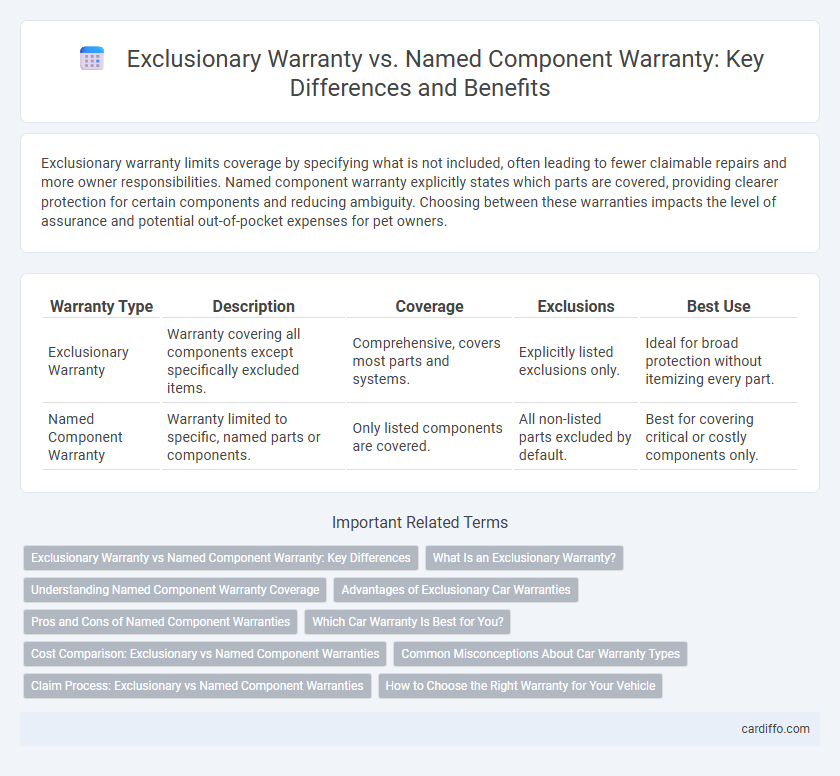Exclusionary warranty limits coverage by specifying what is not included, often leading to fewer claimable repairs and more owner responsibilities. Named component warranty explicitly states which parts are covered, providing clearer protection for certain components and reducing ambiguity. Choosing between these warranties impacts the level of assurance and potential out-of-pocket expenses for pet owners.
Table of Comparison
| Warranty Type | Description | Coverage | Exclusions | Best Use |
|---|---|---|---|---|
| Exclusionary Warranty | Warranty covering all components except specifically excluded items. | Comprehensive, covers most parts and systems. | Explicitly listed exclusions only. | Ideal for broad protection without itemizing every part. |
| Named Component Warranty | Warranty limited to specific, named parts or components. | Only listed components are covered. | All non-listed parts excluded by default. | Best for covering critical or costly components only. |
Exclusionary Warranty vs Named Component Warranty: Key Differences
Exclusionary warranties cover all vehicle components except those specifically listed as excluded, providing broader protection compared to named component warranties that only cover pre-defined parts. Named component warranties limit coverage to particular systems like the engine or transmission, often resulting in more restricted claims. Understanding these distinctions helps consumers choose warranty plans aligning with their risk tolerance and maintenance priorities.
What Is an Exclusionary Warranty?
An exclusionary warranty specifies which parts or components of a product are not covered, limiting the scope of coverage by explicitly excluding certain items. This type of warranty contrasts with named component warranties, which only cover the components specifically listed as protected. Understanding the exclusions helps consumers know which repairs or replacements might incur additional costs.
Understanding Named Component Warranty Coverage
Named Component Warranty coverage specifies protections only for particular parts or systems within a product, limiting the scope to those predefined components. Exclusionary Warranty contrasts by covering all product elements except those explicitly excluded, offering broader default protection. Understanding Named Component Warranty ensures consumers recognize that coverage is constrained to listed parts, potentially requiring additional protection for unlisted components.
Advantages of Exclusionary Car Warranties
Exclusionary car warranties provide broader coverage by covering all vehicle components except those explicitly excluded, ensuring more comprehensive protection for the consumer. This type of warranty reduces the risk of unexpected repair costs since most parts are automatically covered without needing to reference a specific list. Compared to named component warranties, exclusionary warranties simplify claims and increase peace of mind by minimizing disputes over coverage scope.
Pros and Cons of Named Component Warranties
Named Component Warranties offer precise coverage by specifying which parts are protected, reducing ambiguity and potential disputes over repairs. This targeted protection can lower warranty costs compared to comprehensive plans but limits coverage to only listed components, potentially leaving unexpected failures unprotected. Customers benefit from clarity and cost savings while facing the risk of incurring out-of-pocket expenses for non-covered parts or system failures outside the named components.
Which Car Warranty Is Best for You?
Exclusionary warranties offer comprehensive coverage for most parts except those specifically excluded, making them ideal for buyers seeking broad protection with fewer out-of-pocket expenses. Named component warranties focus on specific parts or systems, providing targeted coverage that can result in lower initial costs but higher risk for uncovered repairs. Choosing the best car warranty depends on your driving habits, vehicle reliability, and tolerance for potential repair costs.
Cost Comparison: Exclusionary vs Named Component Warranties
Exclusionary warranties typically offer broader coverage but often come with higher initial costs due to their extensive protection scope, whereas named component warranties limit coverage to specified parts, resulting in lower upfront expenses but potentially higher out-of-pocket costs for excluded repairs. Cost comparison reveals that exclusionary warranties may reduce unexpected repair expenses over time despite their premium pricing, while named component warranties can be more budget-friendly initially but risk significant additional costs for non-covered components. Evaluating repair frequency and vehicle complexity is crucial to determining which warranty type delivers better cost efficiency for individual needs.
Common Misconceptions About Car Warranty Types
Exclusionary warranties cover all vehicle components except those explicitly excluded, often misunderstood as all-encompassing, leading to confusion about repair eligibility. Named component warranties specify only certain parts covered, causing some car owners to mistakenly believe their warranty includes more components than listed. Clarifying these distinctions helps prevent costly surprises during repairs and ensures accurate expectations regarding coverage scope.
Claim Process: Exclusionary vs Named Component Warranties
Exclusionary warranties simplify the claim process by covering all components except those specifically excluded, reducing the need for detailed part identification during a claim. Named component warranties require claimants to specify and prove failure only in the listed parts, often resulting in a more complex and time-consuming verification process. Understanding the scope of coverage in each warranty type directly impacts the efficiency and success rate of warranty claims.
How to Choose the Right Warranty for Your Vehicle
Choosing the right warranty for your vehicle depends on your driving habits and risk tolerance. Exclusionary warranties provide comprehensive coverage with specific exclusions, ideal for drivers seeking broad protection against unexpected repairs. Named component warranties cover only listed parts, which can be cost-effective for vehicles with lower repair risks or for owners willing to manage minor repairs independently.
Exclusionary Warranty vs Named Component Warranty Infographic

 cardiffo.com
cardiffo.com